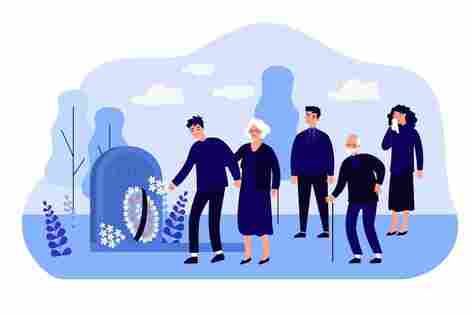CEMETERY MANAGEMENT & CELEBRATION OF LIFE SOFTWARE
|
8/3/2022
facts about funerals that might surprise youWhen most people think about funerals, they imagine a somber ceremony with flowers, prayers, and people dressed in black conversing quietly amongst themselves. While this is true in most cases, modern funerals do not always follow this format.
Funeral details are often rooted in tradition and beliefs. Nevertheless, heartfelt funerary rituals vary, which is why each one is beautifully unique. The Reasons Behind Today’s Funeral Practices If you have ever wondered why we place flowers on graves or if funerals can be boisterous occasions, read on! Romans Inspired the Use of Gravestones When Rome controlled Britain, Roman soldiers erected gravestones close to military forts and Romano-British settlements. This was done to mark the passing of women and children. Roman soldiers were not allowed to marry, so placing gravestones where they could be viewed often was their way of showing respect for the people they cared about. This practice also legitimized the relationship they were unable to have while the woman or child was alive. During the fifth century, Rome lost control of Britain and the ritual of erecting gravestones ended until the modern era resurrected the tradition. Burials Were a Family Affair—Literally Throughout the Anglo-Saxon period, people who chose cremation were not buried immediately. The urn holding their ashes remained in the community until several members of the decedent’s family had died, then all the urns were buried together within a large mound of earth called a barrow. Mourning for Money Moirologists are professional mourners who are hired to attend a funeral. While this may seem odd, it is an ancient tradition that spans the globe and is even mentioned in the Old and New Testaments. It is believed that the practice of hiring moirologists started in China and the Middle East, but this is difficult to pinpoint. There is also evidence of moirologists were employed throughout Egypt. Prior to the 20th century, European families would hire professional mourners to look sad and wail. In Rome, there are accounts of professional mourners attending the funerals of wealthy individuals. Their presence signified that the decedent was part of high society. The moirologists would cry loudly during the burial as they pulled on their hair and clothing. They would even scratch at their face to make their act more dramatic. Today, moirologists are still making a living; however, they are usually hired when the deceased has few living relatives, so their main job is to increase attendance. In South Africa, hired mourners behave similarly to how they acted 2,000 years ago and will even threaten to jump into the grave, but this level of drama comes with an additional fee. Adorning Graves with Flowers Placing flowers on graves is an old tradition. It is believed they bring goodwill to the deceased, and each type of flower carries its own meaning. Roses are placed on a grave to symbolize love, hope, and beauty. Two roses joined together represent a strong bond and are usually placed on a couple’s gravesite. Meanwhile, rose buds are laid on the graves of children, and a rose that is partially open is set on the grave of teenagers to symbolize a life cut short. A rose in full bloom symbolizes that the grave belongs to someone who died in the prime of life. Lilies are another popular gravesite flower as they represent innocence and purity. The Easter lily symbolizes resurrection and innocence of the soul. Lily of the Valley signifies innocence, humility, and renewal. If you pass by an older cemetery in the springtime, you are sure to see daffodils springing from the graves. People planted these flower bulbs because they symbolize grace, beauty, and deep regard. Daisies are another common cemetery flower as they represent gentleness and innocence. If you happen to find a grave covered in ivy, the person who planted it wanted to convey faithfulness, undying affection, and eternal life. Waking the Dead Irish wakes are anything but solemn. While wakes are more informal than funerals, Irish tradition involved playing loud music in the hopes it would ward off evil spirits. However, blasting tunes also served the purpose of ensuring that the person was indeed dead. Ushering the Departed Oftentimes, when a hearse arrives at the cemetery, the funeral director will walk in front of the hearse to guide the driver toward the gravesite. This long-standing tradition dates back to the days when horse drawn carriages delivered bodies to cemeteries. Regardless of when the practice started, guiding the hearse will always be a funeral director’s way of showing respect for the decedent. The Original Green Burial During medieval times, the family of the deceased borrowed or leased a community coffin to transport the body of their loved one from the home to the churchyard. This was performed by the parish church. After arriving at the gravesite, the deceased was removed from the coffin and wrapped in a shroud before being placed into the grave. Saying ‘Hello’ to a New Tradition of Bidding ‘Good-bye’ The timeless traditions of placing flowers on graves and playing music during the service will always be a way for the living to find comfort while honoring the dead. However, flowers wither and every song has a final note. With the advent of technology, people can create a digital legacy that will last forever. A digital legacy is a collection of photos and videos of a deceased person that is uploaded to the internet. These virtual albums often include the person’s favorite music. Usually, the decedent’s loved ones will create the digital legacy to share with others, but it is sometimes featured at the funeral or wake as well. People are even fashioning their own digital legacy prior to their death, so they can be remembered in their own special way. EverArk is the premier software that is making digital legacies the newest funerary tradition. Its user-friendly format allows loved ones to easily upload, view, and share cherished memories of deceased family members and friends. EverArk is even being used by people to create their own digital legacy prior to their death. They appreciate the peace of mind this state-of-the-art software provides as it assures them that their legacy will live on to show future generations what they were like when they were alive. While older traditions will always remain, it is easy to see how digital legacies are blazing the trail for a new tradition. After all, everyone should be remembered in their best light and the internet is a surefire pathway to keeping a loved one’s spirit shining brightly. If you are interested in being a trailblazer by creating a digital legacy for yourself or a loved one who has passed on, request a demo of EverArk today! |
Take a quick tour of EverArkLearn how EverArk can help you manage your cemetery and increase your revenue and growth.
|
Scroll through our features by user typeEverArk provides in-depth functionality for all cemetery users and customers.
Cemetery Management SoftwareCelebration of Life Software & App |
Try before you buy. Or, start with our Pro PlanSign up now and lock yourself into our beta pricing. Our extremely affordable $12 per user/month isn't going to last long.
|
Learn about our partner programWe value great partners and want to establish long-lasting relationships to build upon.
|
Read our latest blogStay informed with our latest blog chatter and industry trends.
|
|
Shop the plots our EverArk customers are selling online.
|
All our resources are at your fingertipsStay informed and explore all of our content, news, jobs, articles, and more. |
Register for EverArkTake the next step in cemetery innovation and get started with EverArk. Click on the type of user you are. |
|
Quick Links
TOURFEATURESPRICINGPARTNERSBLOG
QUICK FACTS |
|
|
|
|
|
© 2024 Eternal Legacy Company LLC. All rights reserved.
EverArk® trademark is owned by Eternal Legacy Company LLC. |
TERMS OF SERVICE |
PRIVACY POLICY |
COOKIE POLICY |
DISCLAIMER |
SITEMAP |
|
U.S. PATENT
DIGITAL LEGACY AND LOCATION SERVICES FOR BURIAL SITES Covered by: U.S. PRV Application No. 15/865,298 |
|



















